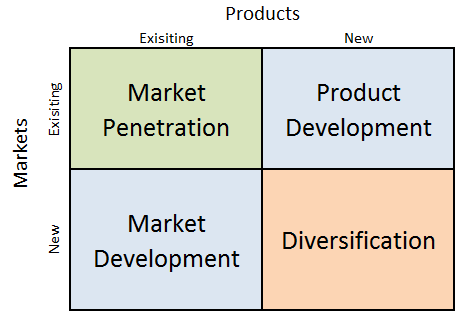Xiaomi Ansoff Matrix
Xiaomi Ansoff Matrix is a marketing planning model that helps the mobile internet company to determine its product and market strategy. Ansoff Matrix illustrates four different strategy options available for businesses. These are market penetration, product development, market development and diversification.

Xiaomi Ansoff Matrix
Within the scope of Ansoff Matrix, Xiaomi uses all four growth strategies in an integrated manner:
1. Market penetration. When using market penetration, companies focus on selling existing products to existing customers. Xiaomi successfully uses market penetration strategy in its home market in China. According to Q1, 2018 smartphone sales results in China, Mi smartphones ranked third with the local market share of 12,8% after Huawei (20,8%), Oppo (18,5%), iPhone (18,2%) and Vivo (14,6%).
2. Product development. This strategy option involves developing new products to sell to existing markets. Xiaomi has ever-increasing product portfolio ranging from smartphones to water purifiers and tooth brushes. Product development strategy is likely to be continued by Xiaomi. This is because Xiaomi positions itself as a “company that provides innovation to everyone at every level — from smartphones and technology to IoT connected smart products to the basic everyday tools like power banks, backpacks and pens”.[1]
3. Market development. Market development strategy is associated with finding new markets for existing products. Xiaomi started market development in 2014, only four years after the company was founded. In mid-2013, the company hired Hugo Barra away from Google and Android to work on international expansion.[2] Since that time, the electronics and software company has established its presence in rapidly developing markets such as India, Singapore and Russia. The mobile internet company also has plans to enter US market.[3]
4. Diversification. Diversification involves developing new products to sell to new markets. Xiaomi is engaged in an aggressive diversification strategy. Xiaomi ecosystem is vast and comprises 55 companies, including 4 unicorn companies[4]. Companies within the ecosystem produce a wide range of products and services such as TVs, set-top boxes, robot vacuum cleaners, headphone and even towels and rice cookers.
Xiaomi Inc. Report contains a full analysis of Xiaomi Ansoff Matrix. The report illustrates the application of the major analytical strategic frameworks in business studies such as SWOT, PESTEL, Porter’s Five Forces, Value Chain analysis and McKinsey 7S Model on Xiaomi. Moreover, the report contains analyses of Xiaomi leadership, business strategy, organizational structure and organizational culture. The report also comprises discussions of Xiaomi marketing strategy, ecosystem and addresses issues of corporate social responsibility.
[1] WE OFFER SMARTPHONES, AND TOOTHBRUSHES (2017) Mi Blog, Available at: http://blog.mi.com/en/2017/08/02/beyond-the-smartphone-why-we-make-consumer-products/
[2] Dowling, S. (2018) “The Rise And Global Expansion Of Xiaomi” Chrunchbase, Available at: https://news.crunchbase.com/news/rise-global-expansion-xiaomi/
[3] Kharpal, A. (2018) “Xiaomi on US market entry: ‘We’ll be there’ CNBC, Available at: https://www.cnbc.com/2018/02/26/xiaomi-on-us-market-entry-well-be-there.html

